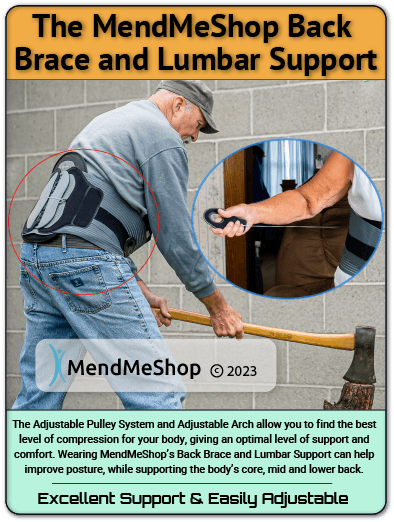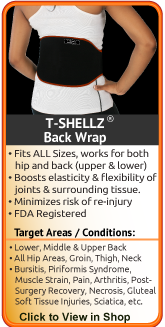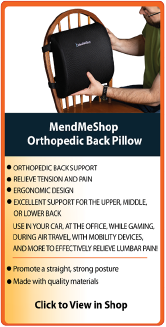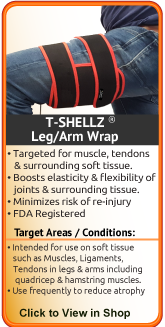Do I Need Hip Surgery?
Hip Surgery is a Last Resort
Not every hip condition requires surgery.
It's generally understood by doctors and surgeons that surgery will introduce more scar tissue into your hip. This added scar tissue will be problematic, requiring physical therapy and often significant treatment post-surgery. If not dealt with properly, your hip could end up in worse condition than before the surgery! This is why surgery is only performed as a last resort.
If You Haven't Done So Yet, Get a Proper Diagnosis
A serious hip tendon tear may be termed as Surgically Necessary (SN) and will require surgery, and in cases of complete tears or detachment, there is really no other option. This is why it is important to get to a physician and find out what is really going on - this is known as getting a proper diagnosis. Getting a proper diagnosis would also determine if your hip pain is a side effect from another condition or disease. This can be very serious, so yes - it is important to get a proper diagnosis.
The Good News
Most hip injuries are not Surgically Necessary, and will heal on their own. This is why most doctors, physicians and orthopaedic specialists will recommend conservative therapy for non-SN hip injuries before considering surgery.
Some of the most effective conservative treatment methods to avoid surgery are:
- Rest - This is important for initial recovery; rest and elevation will help reduce pain, swelling and inflammation in the early stages of injury. This can be difficult when you have to carry on with daily activities, but resting and elevating your hip whenever you can is recommended. During your recovery you will probably have to modify or avoid the activities that put stress on your hip until your pain and inflammation settle. However, too much rest can also be harmful, as knee and hip immobility can actually cause joint stiffening, over-compensation problems and atrophy (shortening & wasting away of muscle and soft tissue). This is why rest should be used when reducing initial pain and swelling, but should not be considered for more long-term conservative treatment.
- Avoid Activities that Caused Your Hip Injury - While resting your injury it's also important to avoid all activities that may have caused your hip damage (especially any strenuous or repetitive movement). Continuing on with regular activities can increase the severity of your injury, turning a mild to moderate case of tissue damage into a downward spiral that can often severely impact your life. Also, trying to 'work around' your injury will eventually give rise to over-compensation injuries in other areas of your body.
- Use a Cold Compress or Ice Pack - Cold is very effective at reducing pain and inflammation - use at the onset of the injury and during flareups.
- Use a Back/Hip TShellz Wrap® - Once swelling has been reduced, you can use your own blood flow to maximize your rehabilitation. Improved blood flow to your hip in most cases will help improve recovery time while improving overall health of tissue in the area. Knowing the body uses blood flow to heal soft tissue, this wrap is designed to maximize your rehabilitation by maintaining a healthy blood flow to soft tissue. Increased blood flow to damaged soft tissue should augment the bodys' own repair process, helping decrease recovery time while reducing re-injury risk. Promoting blood flow and heat to the treatment area will help to minimize the growth of scar tissue, increase tissue flexibility and help reduce onset of atrophy. This is why we recommend TShellz Wrap before undergoing activity - an increase in flexibility should help reduce risk of further injury while also assisting in the battle against atrophy. Heat via the TShellz Wrap® is especially helpful in dealing with chronic tendon & muscle injuries or on-going pain and stiffness from a strained hip. View the Back/Hip TShellz Wrap® in our online shop here
- If you are experiencing discomfort and want to stabilize and compress the lower back and hip, Use a Lower Back Brace - this high quality lower back brace is designed to to be adjustable much like a corset, and has the added benefit of providing excellent support while undergoing activity (including support while lifting) while experiencing a hip injury. The compression level is easily adjustable and is designed not to chafe the skin. In my opinion, this support will pleasantly surprise people experiencing injuries in the lower back, hip and groin - allowing them to experience significant relief from ongoing discomfort. However, if the injury is in the upper leg portion, the back brace may not be applicable - it really depends where the injury is.
- For reducing discomfort while resting, (or to get some sleep) consider a High Quality Back Pillow and/or Knee Pillow for comfort while sleeping or sitting
- Try to Avoid Over Compensating for your Injury on your "'Healthy' (Non-Injured) Side - Many people will start limping or carrying objects with their opposite arm to compensate for their leg injury. Our bodies can adapt easily to any changes, including a hamstring injury. This quick adaptation could mean that you are already compensating for your injury without even knowing it!
When you compensate for your injury by using your opposite ('healthy') arm, leg, shoulder, knee, foot, etc. - then you are putting more weight and pressure on that side of your body. In many cases, your dominant side was injured (if you're right-handed this would be your right side) so your weaker side is trying to pick up the slack! The pain, stiffness, swelling and inflammation you then get on your 'healthy' side is something referred to as 'over-compensation pain'. Over-compensating for your injury can lead to other injuries and as such, it is important to be aware of how you are compensating so you can be extra careful; if there is an overcompensation flareup, treat this with the same conservative treatment methods to keep in under control & don't be too stubborn to use crutches or a cane to help.
- Rehabilitative Stretching under supervision of a PT or doctor. The intent of this is to provide you with increased range of motion, pain relief and strengthening of the surrounding tissue of the joint. Doctors or surgeons typically won't perform a surgery until they feel that their patient has put effort into treating their injury with conservative treatment methods. This may include up to 4 to 6 months of visits to a PT clinic. If you haven't experienced any improvement in your condition during that time then surgery may be considered. Agressive PT approaches may focus on forced or manual manipulation of the hip - this means your physical therapists will be trying to move your leg past the point of comfort as they strive to increase range of motion and prevent further atrophy.
- Stretching - Stretching your joint in PT and at home will help you to regain your range of motion much faster than not stretching at all. Stretching in many ways is key maintaining good Range of Motion (ROM) in your joint, and stretching can be made much easier with use of a TShellz Wrap® before to warm up soft tissue, and a Cold Compress or Ice Pack treatment after to prevent any return of swelling and inflammation.

What Happens When You Are Not Using Conservative Treatment Methods (as Outlined Above)
Soft Tissue Injuries of the hip (this also includes injuries to the upper leg and lower back) are all injuries that cannot really be ignored. If you choose to ignore the injury, then this means you will still be be trying to do certain tasks (ie. using a fork, putting on your seat belt, etc) using soft tissue (strained and/or partially torn ligaments & tendons) that is already compromised. This means it will inevitably get worse.
Here is what to expect:
- Since the tissue is still inflamed, lack of proper blood flow will drop your healing rate to a crawl.
- Continually straining the soft tissue (just by doing daily tasks such as cooking or driving) worsens the injury and will introduce more scar tissue.
- Increased scar tissue buildup will tighten the soft tissue in your hip, decreasing your already limited flexibility.(reduced range of motion)
If you suffer from a painful hip injury, this means that when you get out of bed in the morning and try to walk, crouch or climb stairs, it will hurt a LOT - this is due to reduced flexibility in your core and upper legs.
Since the ligaments/tendons of the hip cannot flex as much as they once did, trying to use it during your simple daily routine just introduces more scar tissue and continuously worsens the injury. As you can see, this is a cycle that can easily become worse and worse, eventually becoming a chronic (long term) injury. This is the cycle you need to stop or you will probably wind up having surgery once your injury becomes chronic.
What Are the Two Biggest "Gotchas" When Treating My Hip Injury Using
Conservative Treatment Methods?
The Absence of Pain Does Not Mean Your Injury is Gone
After most of our clients use a Cold Compress or Ice Pack as instructed, the hip pain eventually decreases significantly. This where most people wrongly associate the pain with the injury, whereas in truth, a lot of the pain really came from the inflammation and swelling. Once the inflammation is gone, do not assume you are fully healed.
Time Is Not Your Friend
So you have used cold compression and most of the pain is gone, but it's been a couple of months and the injury keeps flaring up. If this is you, then you probably know why this is happening now... the injury never fully healed. To really heal a hip injury, you need to rest until it is healed, and you don't need me to tell you this is a pain in the butt! This is why the Back/Hip TShellz Wrap is such an important tool. The whole purpose of this wrap is to try and get you back on your feet in a short time span and avoid the re-injury cycle.
When the swelling has gone down and the pain has reduced, this is the perfect time to use the Back/Hip TShellz Wrap. A treatment with the Back/Hip TShellz Wrap will substantially increase blood-flow to the treatment area - it is basically intended to maximize the natural ability of your body to self heal. We also recommend that our clients treat themselves with the TShellz Wrap® first thing in the morning before getting out of bed. This is important, as we have already shown (Chapter 9 of "Therapeutic Heat and Cold", 4th edition. amazon.com link - Ed. Justus F. Lehmann, M.D., Williams, and Wilkin) that heat will increase elasticity and flexibility in ligaments, muscles and tendons of the hip; it will decrease the chance of re-straining this tissue at their most vulnerable time - after a long period of inactivity. With increased flexibility in an injured hip, you will have a reduced risk of further injury (or re-injury if some healing has already occurred).
Why Your Hip Injury Won't Heal
If our body is designed to heal our own injuries, why does it take so long to heal?
When we have an injured ligament, muscle, tendon or bursa, this means the tissue is damaged. Your body responds to this damage with healing right away. During this healing process the injured tissue spasms. These spasms are contractions, and are meant to hold the tissue still to prevent any further injury. Swelling and inflammation is your body's way of: - Creating localized pain to tell you something is wrong there and to stop moving it, and
- Sending blood to the area to start healing. Healing at this point will also expand the blood vessels in the injured tissue - they enlarge and swell causing you pain. This pain is a signal for you to lessen activity that would put anymore undue stress on your hip.
However, there is are significant problem with swelling and inflammation with regard to healing rate. Once soft tissue is inflamed, blood-flow is restricted. The body heals itself by sending nutrients through the blood to the injured tissue, and if the injured tissue is swollen, the blood-flow is greatly decreased.
Decreased blood-flow to injured tissue, prevents the damaged tissue from healing as fast as it would if the area wasn't swollen.
The other issue is that swelling is also very painful. With many conditions, once you get rid of the inflammation, a lot of the pain will disappear as well.
Once the Pain is Gone, We Think Our Soft Tissue Injury is Healed.
So we start using it more and more for common tasks, and then "boom" we get a sharp pain and then it starts all over. When this happens, the injury was never fully healed - and now it is worse! More scar tissue grows in the new tissue micro-tears and well, lets talk about scar tissue.
Scar Tissue - We Need It For Kick-Starting Tissue Tear Repair
But After That It is Nasty Stuff
Tendons, ligaments, muscle and other soft tissue in the hip are all meant to be soft and flexible, ready to work and move extreme forces in everyday activities. When I say extreme force, I mean try to imagine the amount of forces that your hip handles, even when just walking, let alone jumping or running. Scar tissue grows in damaged tissue when it tries to heal; little tiny band-aids that overlap each other to bind tiny tissue tears together. With this added scar tissue, muscles & tendons & ligaments become rigid, less flexible and unable to handle the forces that it once could. If you're suffering with scar tissue now you may feel the effects with stiffness, tightness, weakness and tiredness in your hip.
Scar tissue can form fast to bring together the edges of a tear, but working fast doesn't mean that the job's done right. When scar tissue forms it doesn't come together as neatly as regular (healthy) tissue would. Scar tissue fibers will lay down over top of your tear in a cluttered, messy and jumbled up way.
On-going issues with scar tissue can result in soft tissue tears and increase chances of strain to nearby tendons or ligaments (as they are now handling higher forces due to overcompensation).
Scar tissue is one of the MAIN reasons why a chronic hip injury has not healed and your Range of Motion (ROM) is reduced from what it once was.
Scar tissue will form fast to deal with a soft tissue achilles injury, and this scar tissue will attach to EVERYTHING in the area, including the surrounding healthy tissue as well. This can result in a fusing together of the soft tissue in your hip that shouldn't be fused together, and this will cause extreme pain when you move the joint - it is literally ripping tissue. This is why physical therapy is often painful - the therapist stretches the joint, forcing the scar tissue bonds to break so you can regain your range of motion.
Scar tissue is a significant problem when it comes to a hip injury - potentially causing your injury to become chronic, and then taking months or even YEARS to completely heal!
You can help reduce the impact and growth of scar tissue and reduce risk of further injury to your hip muscles/tendons/ligaments by 1) increasing blood flow to the area and, 2) increasing the elasticity of soft tissue in the area. Treating yourself with the Back/Hip TShellz Wrap is the easiest and most effective way to help accelerate your recovery at home by increasing soft tissue elasticity which helps reduce the risk of more scar tissue growth.
When applied before activity or work, the TShellz Wrap will also relax and lengthen your soft tissue to help improve your range of motion and prevent atrophy (tissue wasting & shortening) of your injured hip.
Overall, continued treatment with a TShellz Wrap is intended to maintain good health in your soft tissue and significantly reduce your risk of re-injury.
Using a TShellz Wrap® will not expose you to the risk of causing further harm to soft tissue like you can when using rigorous exercise. The Back/Hip TShellz Wrap® accomplishes the goal of enhanced blood flow without the need for intensive exercise and as such reduces your risk of re-injury.
When to use a Back/Hip TShellz Wrap:
- Once the swelling is gone (usually after applying cold compression to the injury over 24 to 72 hr period).
- BEFORE getting out of bed in the morning. BEFORE going to bed at night.
- BEFORE exercise, workouts or activity of any kind to increase elasticity of tendons, ligaments and muscles of the hip and lower back, and decrease the risk of re-injury.
- AFTER surgery (once the skin wound has healed over) to boost blood circulation, helping surgically repaired tissues rebuild for long-term health and minimize scar tissue growth at the surgery location.
- Anytime BEFORE you feel you might undertake activity that will put significant strain on your hips.
- Any other situation where you need to increase blood flow to your injury to relax your hip, relieve trigger point pain / spasms, prevent re-injury and enhance flexibility of your tissue.
- Anytime BEFORE you feel you might undertake activity that will put significant strain on the injury area.
Click Here to Check Product Price
If you have questions, call our office at 1-866-237-9608 (toll free continental US).
Minimize Your Chance of Hip Surgery with these Effective Conservative Treatment Options
If your doctor thinks you might be able to avoid surgery by using conservative treatments, you can join our many customers who have had great success treating themselves with the powerful TShellz Wraps® that we offer through MendMyHip.
Our online shop accepts Visa & Mastercard as well as a Paypal Payment option.
We also encourage your to Call Our Office at 1-866-237-9608 (toll free continental NA) where we can answer any questions you have and/or take your order via phone.
Soft tissue injuries of the hip are common and can happen to anyone. Right now there are thousands of doctors and physical therapists dealing with patients that require a solution to treat their hip injury fast and heal it (where possible). If you want to be pro-active about properly addressing your hip injury by using the best conservative treatments, then you need to use MendMyHip's system utilizing TShellz Wraps® and accessory products.
If Surgery is Required
Talk with your physician about using these same products for post-surgery recovery as you will find them to be highly effective for reducing post surgery inflammation, enhancing range of motion and minimizing scar tissue growth (which is a common problem in nearly any case of significant surgery). Learn more about how to get started with recovery after surgery.
The Next Step Is Up To You!
Living with pain is never easy as it affects your entire lifestyle. Living with pain during or after an intensive surgery and lengthy rehabilitation period can be even harder! What is more important than taking your best shot at trying to heal your hip before signing up for surgery?
Doctors and Surgeons are always improving the technologies used in surgery, and results from surgery now are much more positive than they were in the past. However, all surgeries introduce scar tissue, and recovery from hip surgery is often disappointing. If you do wind up getting surgery, know that rehabilitation at-home while attending regular physical therapy or doctor appointments is vital for your overall recovery. It is especially vital to the hip and knee areas, as they consistently handle extreme forces (body weight). Consistent exercise and conservative treatment on a daily basis during your rehabilitation while working with your doctor, surgeon or physical therapist is key - and this is why you should seriously consider maximizing your recovery by using the TShellz Wrap at home once you are approved for physical therapy.
We strongly believe that we can help you, and we have thousands of happy clients to back this claim. You are welcome to try our products for a 60 day period.. If you are committed to following the treatments outlined in the product instructions we are very confident that our TShellz Wraps will aid you immensely. If you do not receive the benefits that countless of our other customers have experienced from our products, call us, mail the product back to us and we will provide you with a full product refund.

Our online shop accepts Visa & Mastercard as well as a Paypal Payment option.
We also encourage your to Call Our Office at 1-866-237-9608 (toll free continental NA) where we can answer any questions you have and/or take your order via phone.
Product Advisors are available 9:00 am to 5:00 pm Eastern Standard Time Monday to Friday.
Learn More About Hip Joint Injuries & TreatmentsI want to learn more about Hip Surgery & Post-Surgery Recovery I want to learn more about Circulation Boost I want to learn more about Ice & Heat: Which Is Better For The Hip? I want to learn more about Trigger Points in the Hip I want to learn more about Hip Surgery: Do I Need It?
FREE SHIPPING ON ALL OUR PRODUCTS
During your recovery, you will probably have to modify and/or eliminate any activities that cause pain or discomfort at the location of your soft tissue injury until the pain and inflammation settle. Always consult your doctor and/or Physical Therapist before using any of our outstanding products, to make sure they are right for you and your condition. The more diligent you are with your treatment and rehabilitation, the faster you will see successful results!
| 








